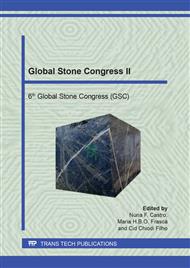[1]
D.H. Meadows, D.L. Meadows, J. Randers, W.W. Behrens III, The limits to growth - A Report to The Club of Rome's Project on the Predicament of Mankind. New York: Universe Books (1972) 205p.
DOI: 10.1349/ddlp.1
Google Scholar
[2]
E.P. do Nascimento, Trajetória da sustentabilidade: do ambiental ao social, do social ao econômico, Estudos Avançados 26, v. 74. (2012) 51-64.
DOI: 10.1590/s0103-40142012000100005
Google Scholar
[3]
G. Bruntland, Our Common Future. Report of the World Commission on Environment and Development, Oxford University Press, Oxford. (1987).
Google Scholar
[4]
J.E. Kogel, N. Trivedi, M.A. Herpfer, Measuring sustainable development in industrial minerals mining, Int. Journal of Mining and Mineral Engineering (IJMME), 5 (2014). 4-18.
DOI: 10.1504/ijmme.2014.058921
Google Scholar
[5]
Associação Brasileira de Normas Técnicas – ABNT, NBR ISO 14040:2009 Gestão ambiental – Avaliação do ciclo de vida – Princípios e estrutura, (2009).
Google Scholar
[6]
N.F. Castro, L.M. Mofati, M.C.B. Gadioli, F.M.R.S. Lima, G. Lovon-Canchumani, L.M. Tarazona-Alvarado, C.C. Peiter, Avaliação de ciclo de vida (ACV) e sua aplicação na mineração, Brazil Mineral, 375 (2017) 34-39.
Google Scholar
[7]
UN Environment – Life Cycle Initiative. http://www.lifecycleinitiative.org/. Last access: 10/21/(2019).
Google Scholar
[8]
K. Awuah-Offei, A. Adekpedjou, Application of life cycle assessment in the mining industry, The International Journal of Life Cycle Assessment, v.16 (2010) 82-89.
DOI: 10.1007/s11367-010-0246-6
Google Scholar
[9]
Center of Environmental Science (CML). Life cycle assessment— an operational guide to ISO standards. Center of Environmental Science, The Netherlands. (2001).
Google Scholar
[10]
ISO TC 207 (2004) ISO 14001: 2004 environmental management systems—requirements with guidance for use. ISO, Switzerland. (2004).
DOI: 10.1016/b978-075064843-1/50004-3
Google Scholar
[11]
A. Hollberg, J. Ruth, LCA in architectural design—a parametric approach. In: The International Journal of Life Cycle Assessment, 21(7) (2016) 943-960.
DOI: 10.1007/s11367-016-1065-1
Google Scholar
[12]
M. N. Nwodo, C.J.F. Anumba, S. Asadi, BIM-based Life Cycle Assessment and Costing of Buildings: Current Trends and Opportunities. ASCE International Workshop on Computing in Civil Engineering 2017·.
DOI: 10.1061/9780784480847.007
Google Scholar
[13]
Instituto Brasileiro de Informação em Ciência e Tecnologia – IBICT. Metodologia padrão para a elaboração de inventários de ciclo de vida da indústria brasileira. Documento consolidado. Brasília: IBICT, (2009).
DOI: 10.35643/info.26.2.12
Google Scholar
[14]
Associação Brasileira de Normas Técnicas – ABNT. NBR ISO 14044:2009. Gestão ambiental – Avaliação do ciclo de vida – requisitos e orientações. (2009).
Google Scholar
[15]
Sustainable Brands. PE INTERNATIONAL Announces Rebranding as thinkstep and Introduces the thinkstep.one Technology Platform to Accelerate Sustainability for All Companies - Sustainable Brands, 2015. <https://sustainablebrands.com/read/press-release/pe-international-announces-rebranding-as-thinkstep-and-introduces-the-thinkstep-one-technology-platform-to-accelerate-sustainability-for-all-companies>. Last access: 10/21/(2019).
Google Scholar
[16]
R. Frischknecht, N. Jungbluth, H.-J. Althaus, G. Doka, R. Dones, T. Heck, S. Hellweg, R. Hischier, T. Nemecek, G. Rebitzer and M. Spielmann, 2005, The ecoinvent database: Overview and methodological framework, International Journal of Life Cycle Assessment 10, 3–9.
DOI: 10.1065/lca2004.10.181.1
Google Scholar
[17]
D.V. Souza, F.W.H. Vidal, N.F. Castro, Estudo comparativo da utilização de teares multilâmina e multifio no beneficiamento de rochas ornamentais, In: JORNADA DE INICIAÇÃO CIENTÍFICA, 20, 2012, Rio de Janeiro. Anais da XX Jornada de Iniciação Científica - CETEM. Rio de Janeiro: CETEM/MCTI, (2012).
DOI: 10.19146/pibic-2015-38161
Google Scholar
[18]
N. Careddu, O. Cai, Granite sawing by diamond wire: from Madrigali bicycle, to modern multi-wires, Diamante – Applicazioni & Tecnologia, n. 79, Anno 20 (2014) 33-50.
Google Scholar
[19]
Associação Brasileira da Indústria de Rochas Ornamentais. Estimativa da serragem de chapas de rochas ornamentais no Brasil. Informe 05/2012. 5 p.
DOI: 10.11606/d.18.2015.tde-16112015-092931
Google Scholar
[20]
Associação Brasileira da Indústria de Rochas Ornamentais. O setor brasileiro de rochas ornamentais. Julho, (2018). 4 p. http://abirochas.com.br/wp-content/uploads/2018/06/Panorama/ Atividades_Setoriais_Brasil.pdf.
DOI: 10.11606/d.18.2007.tde-07052008-085848
Google Scholar
[21]
M.C.B. Gadioli, N.F. Castro, A.A. Pazeto, C.E.R. Wandermurem, P. F. Almeida, D.P. Tavares, Life-cycle inventory of dimension stones, Brazil. In: Proceedings of Global Stone Congress, Borba, (2012).
Google Scholar
[22]
J.M.F. Mendoza, C. Capitano, G. Peri, A. Josa, J. Rieradevall, X. Gabarrell. Environmental management of granite slab production from an industrial ecology standpoint, Journal of Cleaner Production 84 (2014) 619-628.
DOI: 10.1016/j.jclepro.2014.03.056
Google Scholar
[23]
M. Taxiarchou & I. Kostopolou, Life Cycle Analysis of dimensional stones production, In: 3rd International Conference on Sustainable Development Indicators in the Mineral Industry, Milos Island, Greece, (2007).
Google Scholar


